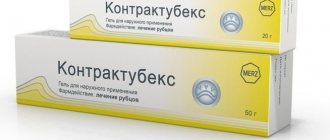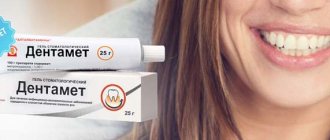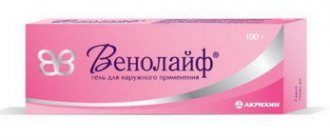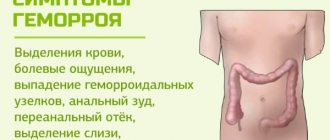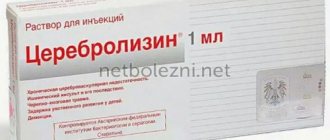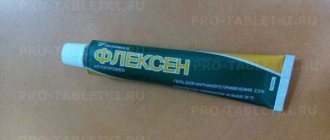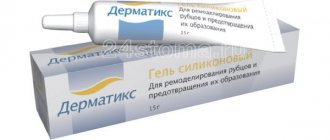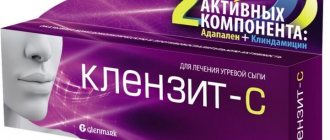Composition, release form
The medication is available to the patient in the form of a gel for external use. It is a transparent dense mass with a characteristic menthol aroma.
The gel is easily distributed over the skin and is well absorbed, packaged in aluminum tubes of 15, 30, 50 or 100 g. Each tube is in an individual cardboard box and is accompanied by instructions for proper use.
The medication contains 2 active ingredients - ibuprofen in an amount of 50 mg and levomenthol in a dosage of 30 mg. A similar amount of ingredients is required for 1 g of gel.
The composition also contains auxiliary ingredients:
- Ethanol.
- Carbomer.
- Propylene glycol.
- Purified water.
Excipients do not have a therapeutic effect, since the main therapeutic effect is achieved due to the presence of 2 active components.
pharmachologic effect
The active ingredients of Deep Relief are ibuprofen and levomenthol. The actions of these components have a mutually reinforcing effect and are aimed at various parts of the pain syndrome.
Ibuprofen has a pronounced anti-inflammatory, analgesic, antiexudative and antipyretic effect. Levomenthol (or menthol) has an irritating and distracting effect. By irritating nerve endings, these substances promote vasodilation and regulate pain sensitivity, providing a local analgesic effect.
The drug is well absorbed and penetrates deeply into the skin and soft tissues.
Operating principle and effectiveness
The principle of action of the product is to quickly eliminate pain when applied externally due to the content of a large amount of ibuprofen as the main active component. The drug not only eliminates pain, but also has a local anesthetic effect, which helps prevent the recurrence of discomfort after a short period of time.
Additionally, the medication has anti-inflammatory properties. The ingredients of the composition prevent the spread of particles through the tissues that provoke the inflammatory process, which slows down the progression of the pathology and helps prevent the development of severe complications.
It is also worth noting that one of the advantages of the product is considered to be the ability to penetrate deep tissues and act directly in the affected area.
The drug helps eliminate tissue swelling, improves the condition of joints and muscles, and reduces the temperature in the affected area. As a result, the patient’s condition is significantly improved, the inflammatory process is suppressed, which has a beneficial effect on the tissues.
The effect of the main ingredients on muscle fibers and cartilage tissue prevents the spread of the pathological process, as well as the complete destruction of cartilage during the chronic course of the disease.
The advantage of the product is its rapid action. The therapeutic effect is felt within 15-20 minutes after applying and rubbing in the gel. That is why the medication is very effective and is often used to relieve acute manifestations of various inflammatory, degenerative-dystrophic diseases of joints, muscle fibers, and ligaments.
In addition, the product has a local irritating effect, which leads to relief from pain by distracting the patient. Atypical sensations are observed in the area of application, which distract the patient from the underlying disease.
However, during this time, the active components penetrate the affected area, providing an analgesic effect. Thanks to the complex effect on the area of inflammation, acute manifestations are eliminated and the course of the pathology improves.
When the gel is applied to the skin, its absorption occurs quite quickly. In this case, a small amount of active components penetrates the systemic bloodstream, which is considered another advantage of the therapy.
It is worth noting that when used on areas of the body with thin skin, rapid absorption occurs. When subcutaneous fatty tissue is expressed, a slowdown in the absorption process is observed.
In patients who suffer from any chronic skin pathologies, there is a slight slowdown in the absorption of the active ingredient, which to some extent affects the effectiveness of therapy. The active ingredients of the product do not accumulate in the blood, but can remain in the tissues for some time, which ensures a prolonged effect.
The main amount of substances entering the blood is processed during the day in the liver, breaking down into metabolites. Decomposition products are eliminated mainly through the kidneys within 1 day. A small amount of metabolites is evacuated in the feces.
In patients with disorders of the digestive tract, there is a slowdown in the processing and excretion of active ingredients, which has almost no effect on the effectiveness of treatment.
Operating principle
Gel for external use. After application, levomenthol stimulates the skin. After the nervous system has received impulses, the synthesis process begins. The vessels dilate. Ibuprofen activates the metabolism of acids in cells and reduces pain. Thus, two components simultaneously help get rid of pain and stop the inflammatory process .
It has very low absorption into the body's blood.
Indications for use
Deep Relief gel is used for various pathologies of the musculoskeletal system with severe pain and signs of inflammation.
Instructions for its use suggest appointment in the following cases:
- Radiculitis of various forms and degrees of neglect, in which there is not only pain in the lumbar spine, but also discomfort in the lower extremities on one or both sides.
- Osteochondrosis in acute and advanced form. In this case, the drug can be used even when diagnosing a herniated disc that occurs against the background of advanced osteochondrosis.
- Pain in muscles and joints during heavy loads or professional sports.
- Bruises, sprains and dislocations, accompanied by the formation of a hematoma. The appearance of severe pain and impaired ability to move.
- Arthritis in acute form, but without the development of a purulent process in the joint capsule.
- Bursitis, accompanied by inflammation of the synovial bursa, but occurring without the development of suppuration.
- Arthrosis of the knee and hip joint. The remedy does not help to significantly improve the condition of an advanced pathological process, but it somewhat alleviates the condition, which is also considered a good effect.
- Damage to small joints of the hands and feet.
- Tenosynovitis in acute and chronic form, when the patient feels discomfort not only during exercise, but also at rest.
The product can also be used to treat damage to the musculoskeletal system during professional sports, as well as to prevent such complications, which often arise when the muscles are not warmed up sufficiently before serious exercise.
Pharmacodynamics and pharmacokinetics
Deep Relief belongs to a group of combined drugs that are intended exclusively for external use. The non-steroidal anti-inflammatory drug (hereinafter referred to as NSAID) ibuprofen is effective in the symptomatic treatment of pain in the joints, ligaments, muscles and tendons ; it has a clear analgesic, anti-exudative, as well as anti-inflammatory effect on the lesions.
Menthol or levomenthol is characterized by its local irritating effect , which helps to achieve an immediate analgesic effect. The drug reduces pain that occurs in the joints, both during movement and at rest, and also significantly reduces their stiffness.
Contraindications and side effects
Deep Relief gel (the instructions for use of the medication describe all the rules of treatment) is not prescribed if you are intolerant to the main or any additional component of the composition, as well as if you are prone to allergic manifestations.
Other contraindications include the following:
- A severe form of renal and liver failure, in which there is a significant deterioration in the functioning of the organ.
- Bronchial asthma of varying forms and severity.
- The patient has a history of intolerance to drugs based on acetylsalicylic acid.
- Violation of the integrity of the skin in the area of intended application of the drug.
- The period of pregnancy and lactation is considered an absolute contraindication, which is due to insufficient data on the effect of the medication on the body of the mother and the unborn child.
- The patient's age is up to 14 years. This contraindication is associated with the aggressive effect of the product on the skin and an increased risk of developing local complications.
- Angina pectoris and severe heart failure, in which frequent exacerbations of the condition are observed.
- Pathologies of the gastrointestinal tract, accompanied by ulcerative lesions of the mucous membranes. In this case, the medication can provoke serious complications, as well as worsening the course of the disease.
The product is used with extreme caution for patients who suffer from chronic pancreatitis. In each case, the list of contraindications may increase.
Deep Relief
The product often leads to the development of complications, especially if the instructions for use are not followed. It is worth remembering that following all recommendations does not guarantee the prevention of complications.
| Organs and systems | Most common complications |
| Nervous system | During treatment, headaches and dizziness may occur, as well as an increase in blood pressure. Symptoms are associated with the active penetration of ingredients into the blood and the development of complications. After stopping use, the condition normalizes; in some cases, symptomatic therapy is required. |
| Digestive tract | Disorders from the digestive tract are observed very often. At the same time, patients report pain in the stomach, bloating and increased gas production. Sometimes the symptoms are aggravated by nausea, stool upset, and loss of appetite. Patients report severe thirst, dry mouth, and indigestion. Typically, such complications occur in patients who suffer from chronic diseases of the digestive system. |
| Musculoskeletal system | Quite rarely, the use of the product leads to increased pain. Sometimes the patient does not feel the therapeutic effect, but reports a burning sensation in the deep tissues in the area of application. |
| Skin | Complications occur most often from the skin. They are accompanied by the appearance of a skin rash, irritation and peeling. Many patients report itching, which intensifies when the skin comes into contact with clothing or household chemicals. |
The severity of a particular manifestation depends on the duration of use of the medication and the number of applications per day. In addition, complications occur with varying degrees of intensity in different patients.
Deep Relief gel (instructions for use should be studied before use) rarely provokes an overdose. Such cases have not been recorded by specialists, but doctors do not exclude the risk of developing such a disorder with long-term use of the drug in high dosages. In this case, the general condition worsens, weakness and shortness of breath are observed.
All negative manifestations become more pronounced. A mild form of an allergic reaction can develop into acute urticaria or Quincke's edema. In the first case, the patient's body becomes covered with large red spots, and there is severe itching and burning of the skin when trying to scratch. The condition is aggravated by rhinitis or conjunctivitis.
With Quincke's edema, not only external signs of an allergic reaction appear, but also difficulty breathing as a result of severe swelling of the mucous membranes of the upper palate and throat. Such a violation can provoke suffocation. Therefore, it requires timely treatment.
If negative reactions or symptoms of overdose occur, you should immediately visit a doctor. In some cases, a few hours are enough to normalize the condition; in others, treatment is required for 3-7 days to completely relieve symptoms.
Contraindications
There is no need to use the gel if you are intolerant to the components of the product and have a high sensitivity to ibuprofen, bronchial asthma, impaired skin integrity, pregnancy, breastfeeding, or heart failure. If applied to damaged skin, the risk of side effects will be much higher; the product may enter the bloodstream . Not recommended for children under 14 years of age.
Does not have a negative effect on the organs of vision.
Instructions for use
The gel is used only for external application to the skin in the area of inflammation, sprain or bruise. The standard therapeutic regimen involves applying a thin layer of the product to the affected area and then rubbing it into the skin in order to accelerate the achievement of a therapeutic effect.
The maximum duration of the therapeutic course is 10 days. It is worth remembering that the treatment is allowed to be repeated no more than 4 times a day. It is not allowed to apply the product under a bandage; this may cause irritation of the skin, even in the absence of an allergy to the composition of the medication.
If there is no therapeutic effect, the specialist does not prolong the course of therapy, but prescribes another drug. It is allowed to repeat the therapeutic course no more than 3 times a year and in the absence of contraindications. In addition, one-time use of the product is allowed for a bruise or sprain. Usually one use is enough to achieve improvement, but in some cases the drug is used for 3 days in a row.
special instructions
Deep Relief gel (instructions for use is considered the main guide for treatment) is strictly contraindicated for application to mucous membranes. After distributing the product over the skin and rubbing it in, it is important to wash your hands thoroughly with soap.
If there is no therapeutic effect during the first 3 days of therapy, you should consult a doctor who will determine the cause and may prescribe another medication that is more suitable for the patient.
If the patient has a history of chronic kidney pathology, he should first consult with a doctor in order to prevent complications. If negative reactions from the digestive system occur, you should stop using the gel and visit a doctor.
Analogues of Deep Relief
Level 4 ATC code matches:
Voltaren Emulgel
Ultrafastin
Indomethacin
Dicloran
Dicloran Plus
Dolgit
Nise
Ketonal
Ketorol
Febrofeed
Fastum gel
Diclofenac
Finalgel
Bystrumgel
Butadion
Diklovit
Artrosilene
Olfen
Fanigan Fast
Methindol
Currently, there are no structural analogues of the drug, however, there are drugs whose mechanism of action does not differ from Deep Relief, for example, Alorom, Algasan, Apizartron, Bainvel, Bengay, Boifriz, Vipratox, Viprosal, Gevkamen, Gederin, Kapsicam, Turpentine ointment, Finalgel, Finalgon, Espol and others.
Analogs
There are many analogues of the drug that have the same medicinal properties and also contain similar active ingredients:
- Capsicam is an irritating and analgesic ointment for external use, which is highly effective and helps eliminate the most severe disorders of the musculoskeletal system. The product warms the affected area, eliminates pain, relieves inflammation and reduces local body temperature.
- Finalgon – an effective medicine in the form of an ointment, which is also used externally for arthritis, arthrosis, osteochondrosis and other pathologies of the musculoskeletal system. The remedy is considered very effective, helps to cope with the most severe manifestations and is relatively safe for patients.
- Nise gel is a popular analgesic and anti-inflammatory gel that is used for pain in the joints, spinal column, and muscles. Helps eliminate acute manifestations, prevents the development of complications, and is considered a good remedy for quick pain relief for injuries.
Any analogue is used only for its intended purpose and according to the correct regimen, which helps prevent the development of complications.
Anti-inflammatory gel Deep Relief has pronounced analgesic properties and helps prevent the progression of pathologies. Instructions for its use involve prescribing after a preliminary examination and identification of the cause of discomfort.
How does Deep Relief work?
The therapeutic effect of the drug Deep Relief is due to the combination of 2 active components that mutually enhance and complement each other.
The carriers of pharmacological activity are:
- Ibuprofen is a non-steroidal anti-inflammatory drug, part of the group of propionic acid derivatives. The mechanism of action of this active substance is associated with a non-selective blockade of both forms of the enzyme cyclooxygenase, which catalyzes the reaction of conversion of arachidonic acid and its conversion into prostanoids. These are constantly synthesized highly active regulators of many physiological processes in the body. The therapeutic effect is achieved by inhibiting cyclooxygenase isoform COX-2, which begins to function in response to tissue damage and activation of the inflammatory response. It is COX-2 that is responsible for the increased production of prostaglandins - mediators that increase the sensitivity of free nerve endings (nociceptors) to pain stimuli. Ibuprofen inhibits the biosynthesis of prostaglandins at the peripheral tissue level (directly in the pathological focus) and at the level of the central nervous system. All possible adverse reactions are associated with the suppression of COX-1, which determines the basal level of prostaglandins.
- Levomenthol is the active (levorotatory) isomer of menthol. Due to its ability to stimulate cold receptors in the skin, it has an irritating, cooling effect and causes reflex reactions. Levomenthol has weak local anesthetic properties due to the temporary suppression of the excitability of the endings of sensory nerves located in the superficial layers, the thickness of the skin and subcutaneous fatty tissue, inhibition or interruption of the chain of pain impulses, and the formation of a distracting effect. The substance also exhibits some antiseptic activity.
Deep Relief has a local effect - the effects of using the gel develop directly at the site of application. The drug is practically not absorbed into the systemic circulation, therefore therapeutic doses of the gel do not exhibit a resorptive effect and, accordingly, do not provoke numerous side effects, which distinguishes Deep Relief from Ibuprofen preparations intended for oral, rectal or parenteral administration. Active compounds penetrate into the deep layers of the skin, articular, muscle, and other soft periarticular tissues, and are concentrated mainly in the synovial fluid.
Read: instructions for use of Wobenzym.
By acting in several directions at once and simultaneously influencing various links in the occurrence of pain and the development of inflammation, Deep Relief provides the following result:
- dilates the superficial vessels of the skin, which is accompanied by an almost instantaneous feeling of coolness, a decrease in irritation, itching, and muscle pain associated with overwork;
- eliminates the feeling of pain in the joints, lumbar region, muscle rigidity, joint stiffness, increases the volume and amplitude of movements, returns painless motor activity. Due to the presence of levomenthol, pain relief occurs quickly - after 15-20 minutes, even severe pain is reduced by half, the effect lasts 3-4 hours;
- reduces swelling, prevents inflammatory changes in the joint, accumulation of exudate, and dysfunction of the affected organ;
- promotes the dilation of blood vessels in the area treated with the gel, improves blood circulation in the inflamed tissue, enriches the adjacent affected structures with nutrients and oxygen, limits further damage and accelerates the healing of affected tissues;
- reduces the level of thromboxane, which plays an important role in the process of blood coagulation, namely, having a vasoconstrictor and proaggregant effect, disrupts the process of platelet aggregation and thrombus formation in the lumen of a blood vessel. Due to the insufficient permeability of Ibuprofen into the hematopoietic system, the antithrombotic effect of Deep Relief is expressed to a small extent - only 5% of the significance of the penetration of Ibuprofen, provided by other routes of administration into the body.
